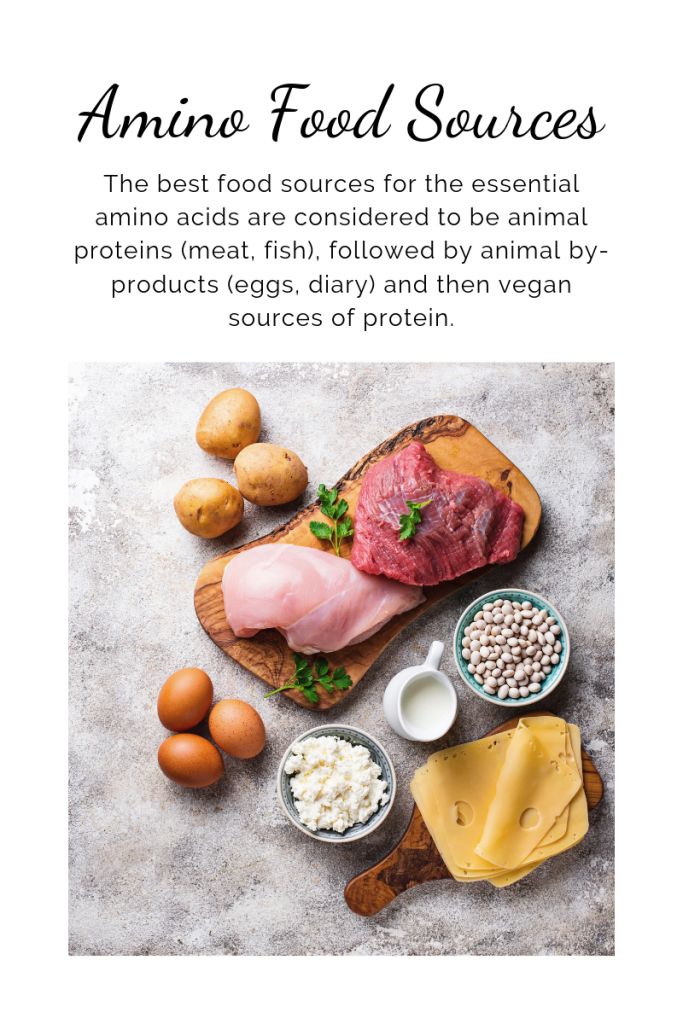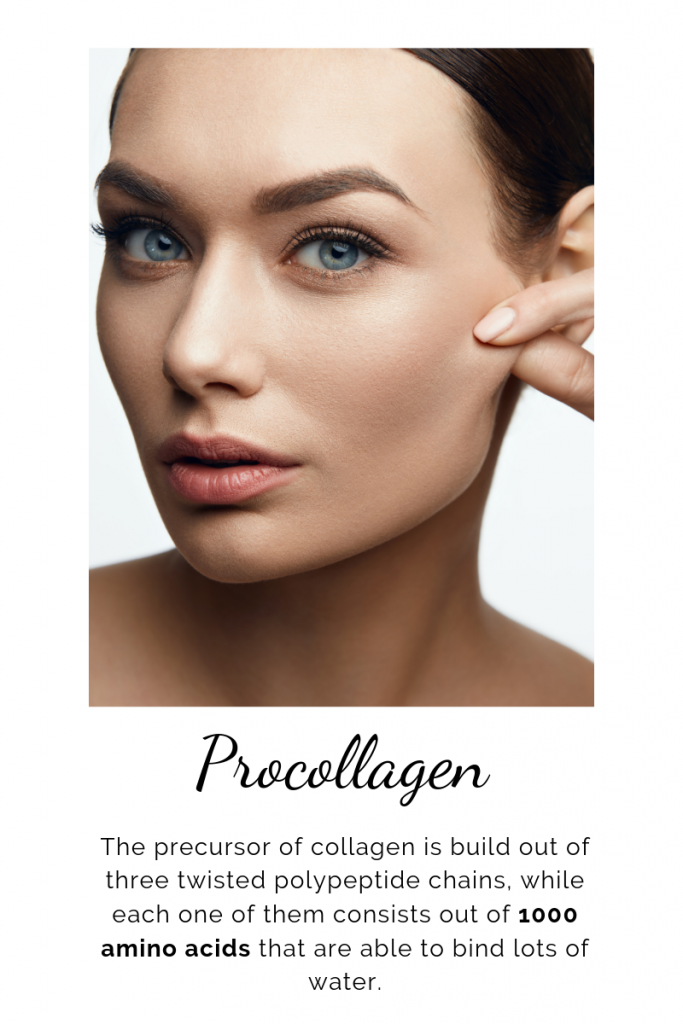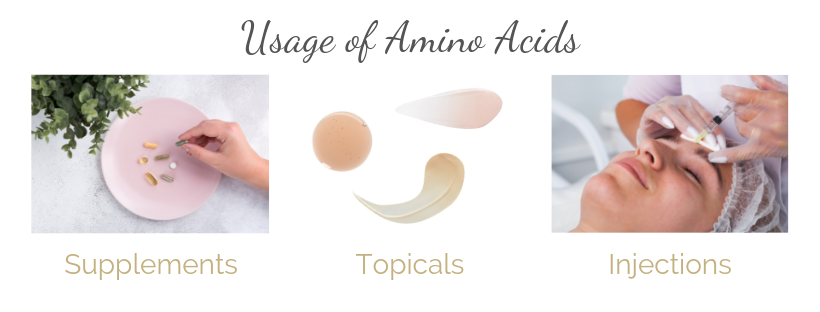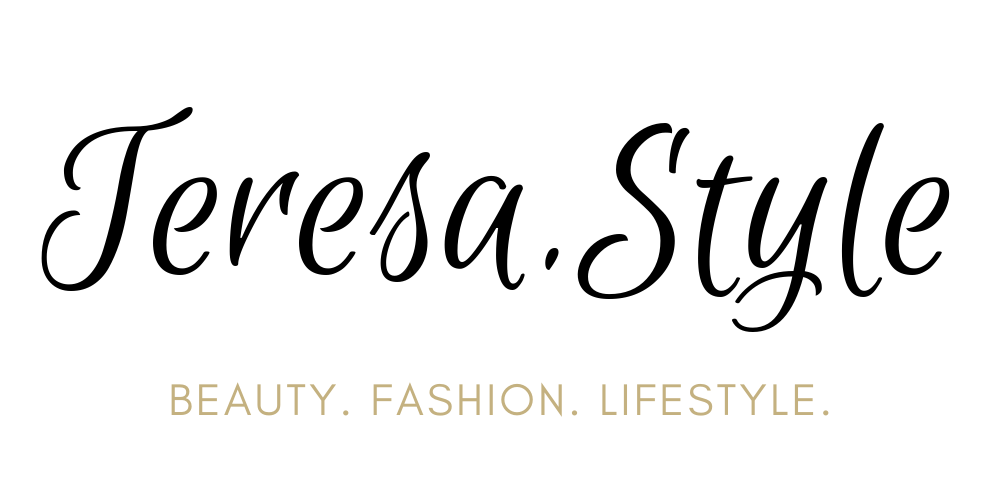Amino Acids
The less known but highly beneficial support for your skin health
What are Amino Acids?
Amino acids are building blocks that connect in order to form polymer chains, which are essential for all living on earth. They can form either short polymer chains (peptides) or long polymer chains (polypeptides or proteins) which are elementary for the biosynthesis of our bodies. The produced proteins support the construction of all kinds of connective tissue, such as muscle tissue, nervous tissue or epithelial tissue (e.g. epidermis – outermost layer of skin).
Why are Amino Acids important for our bodies?
As amino acids play a major role in the biosynthesis and the neurotransmitter support, they are highly involved in the production, regeneration and recreation of our cells. Since they support essential processes such as the production of hormones, the development of muscular structure, the functionality of the nervous system and the vitality of our organs, they are crucial for maintaining a healthy body system. A lack in certain essential amino acids can cause physical uneasiness like fatigue, skin irritations, hormonal imbalances or even mental discomfort such as depressions.
How can they be categorized?
There are more than 500 known amino acids and due to a high variety in characteristics they can be categorized in a lot of different ways, while most of them are very scientific and not necessary to know for our purposes.
What you should know is that there are several hundred of non-proteinogenic amino acids which are either not found in proteins or are not produced directly and therefore in isolation by standard cellular machinery. However, there are 22 proteinogenic amino acids which are responsible for building protein through peptide chains. Two of them, selenocysteine and pyrrolysine, are incorporated by a unique synthetic mechanism and are not present in human bodies. The remaining 20 proteinogenic amino acids appear in our genetic code, thus only eight of them are so called essential and must be obtained through food or supplements, since our body cannot produce them by itself. Amino acids that our body can provide for itself are called non-essential amino acids and are synthesized by microorganisms living in the human digestive tract. However, some of these 12 non-essential amino acids cannot be produced by our bodies under particular conditions such as illness or at a certain age and are therefore called conditionally essential amino acids.
Table 1: Differentiation of the 20 proteinogenic amino acids
| Essential | Non-Essential | Conditionally Essential |
| Histidin Isoleucine Leucine Lysine Methionine Phenylalanine Threonine Tryptophan Valine | Alanine Asparagine Aspartic acid / Aspartate Glutamic acid / Glutamate Serine | Arginine Cysteine Glutamine Glycine Proline Tyrosine |
Since all 20 amino acids that can be found in human DNA are proteinogenic, they are obtained from food that is rich in protein. This not only includes animal based proteins like salmon, beef, poultry, eggs and diary (milk, cottage cheese), but also plant based protein sources like quinoa, soy beans, lentils, peas or nuts. The best food sources for the essential amino acids are considered to be animal proteins (meat, fish), followed by animal by-products (eggs, diary) and then vegan sources of protein.


Why are Amino Acids important for our skin health?
There are many substances and processes in the human body that keep our skin smooth, hydrated and prevent it from drying out by keeping the moisture barrier strong. One of them are the Natural Moisturizing Factors (NMFs) – hydrophilic (water loving) molecules, that bind water in the epidermis along with the hydrolipidic layer and can be found in several substances, such as uric acid, lactic acid and amino acids. As amino acids play a major role in the protein building blocks of collagen and elastin, they are furthermore responsible for the skin’s firmness and elasticity. The vital functions of hydration, firmness and elasticity of amino acids become even clearer when we look at the formation of procollagen: The precursor of collagen is build out of three twisted polypeptide chains, while each one of them consists out of 1000 amino acids that are able to bind lots of water. However, the skin’s ability of binding water and producing collagen decreases as we age, resulting in dryer skin, fine lines and our facial tissues lose their firmness – that is when additional amino acids can make a change. Furthermore, some amino acids have repairing functions and work as antioxidants that support the detoxification of our skin cells.
All in all, amino acids maintain hydration, firmness and elasticity, while also protecting the skin from oxidative stress, providing a youthful and healthy appearance of our skin. Therefore amino acids help to prevent tissue breakdown that becomes visible to us as dehydrated skin, fine lines, wrinkles and scarring (caused through wounds, stretch marks or even acne).
Why should I use Amino Acids if I can use Collagen?
Even though I do not have any scientific proof, I believe in general that precursors of certain substances can be synthesized and used better by our body system than giving the finished product. My logic in this is if you take a finished product, it can be produced in a way that especially your body has problems to use its benefits, while other people can benefit more from the advantages. Therefore I assume that giving the original trigger to our body system in order to produce a certain substance, each and every body can synthesize the trigger in its best way for the individual body type. Maybe you could compare it to the benefits of eating a fresh peach full of vitamins and taste, instead of a peach from a tin – where taste might be good but vitamin levels are very low.
Furthermore, collagen applied as a topical is not very effective as a precursor of collagen production, as it is unable to penetrate the deeper layers of your skin (dermis) due to its big molecule structure – it actually just helps to moist our skin.
Which are the most important Amino Acids for the skin?
Since amino acids produce proteins that support the construction of all kinds of connective tissue (muscle, nervous or epithelial tissue), most of them have multiple functions while some of them are specialized in a certain type of tissue synthesis. I personally would categorize these specializations by three major beneficial areas: mental, physical and esthetic health.
Health issues concerning mental health such as depressions, fatigue, lack of sleep and concentration are often triggered by imbalances in the nervous system and can be treated or diminished with the following amino acids: Arginine, Aspartate, Glutamate, Glycine, Cysteine, Tyrosine, Lysine, Methionine, Phenylalanine, Tryptophan, Threonine, Valine, Histidine.
Overall physical health, especially regarding sportive activity such as muscle growth, can be supported with an additional intake of amino acids. A very common use of amino acids in sports are the BCAAs – Branched Chain Amino Acids (Isoleucine, Leucine and Valine) – supporting muscle build-up with less muscle breakdown and ensuring a postponed fatigue for endurance training. Not only do they help to strengthen ligaments, cartilage, bones and muscles, but they also support the metabolism regarding diets and appetite suppression. The following amino acids belong to this area of specialization: Alanine, Arginine, Asparagine, Aspartate, Glutamine, Cysteine, Glycine, Proline, Serine, Tyrosine, Isoleucine, Leucine, Lysine, Methionine, Threonine, Valine, Histidine.
Table 2: Specialization Groups of Amino Acids (Independent Illustration)
| E, NE, CE | Mental Health | Physical Health | Esthetic Health | |
| Alanine | NE | x | x | |
| Arginine | CE | x | x | x |
| Asparagine | NE | x | ||
| Aspartate | NE | x | x | x |
| Cysteine | CE | x | x | x |
| Glutamate | NE | x | ||
| Glutamine | CE | x | x | |
| Glycine | CE | x | x | x |
| Histidine | E | x | x | x |
| Isoleucine | E | x | ||
| Leucine | E | x | x | |
| Lysine | E | x | x | x |
| Methionine | E | x | x | x |
| Phenylalanine | E | x | ||
| Proline | CE | x | x | |
| Serine | NE | x | ||
| Threonine | E | x | x | x |
| Tryptophan | E | x | x | |
| Tyrosine | E | x | x | x |
| Valine | E | x | x | x |
Esthetic health does not only involve skin health, but also the health of our hair, nails or even teeth. As already mentioned, skin health benefits of amino acids include the hydration and protection of the skin, as well as repairing and balancing functions. Some amino acids can also benefit healthy hair and nail growth or support our oral health. In the following paragraphs I have listed the most important beauty beneficial amino acids with a more detailed background information.
I would like to start with the detailed description of the essential amino acids for skin health, so those who have to be obtained by food or supplements, since the body is not capable of producing them from scratch.
- Histidine is vital for the creation of blood cells and responsible for the high concentrations of it in hemoglobin (red blood cells). This amino acid keeps our pH-values and our gut health balanced of which both can have a major influence on our skin health (infections, breakouts, redness). However, Histidine is also an antioxidant that neutralizes free radicals and may support the natural UV-light protection from within.
- Leucine is particularly known for supporting the production of growth hormones, which are responsible for tissue reproduction and therefore for repairing and healing wounds. This makes it especially beneficial for scar treatments resulting from stretch marks, acne or surgery. Furthermore, it may diminish the look of fine lines and wrinkles when used in combination with the amino acids Glycine and Proline. Besides the skin benefits, an additional intake of leucine can counteract hair loss, as it is a component of the potassium ion channels of hair follicles.
- Lysine plays an essential role in the structural crosslinking between the three helical polypeptides in collagen production, providing the skins stability and tensile strength. As a result, it visibly helps to keep the firmness of the skin’s surface by reinforcing its supportive elements. It is also involved in the production of growth hormones for cell reproduction and regeneration, so it delivers a repairing function for the skin and also for damaged hair.
- Methionine is vital for the protection of our skin barrier from free radicals and oxidative stress (pollution, sun, smoke) as it is a substrate of the mother of all antioxidants called Glutathione. Not only does Glutathione neutralize free radicals before they can harm the skin, but it also maintains exogenous antioxidants such as Vitamin C and E in their active forms which have anti-aging benefits (can be increased with cysteine & glycine). Furthermore, Methionine helps our bodies with the absorption of selenium, sulfur and zinc, three anti-inflammatory minerals, considered to have major anti-aging effects. At this point you should know that scientist found out, that the actual process of aging is an inflammation process, therefore any anti-inflammation benefit will automatically have an anti-aging effect. In addition, Methionine is able to strengthen the structure of hair and nails due to its capacity to form sulphurous chains which in turn are important for the production of keratin (protein structure of the hair shaft). The antioxidant function of methionine furthermore protects the hair follicles from oxidative stress that may reduce hair growth. The earlier mentioned sulfur production through methionine also improves the hair’s texture and strength.
- Threonine is an amino acid, that is less important for the skin health because it does not directly influence the production of collagen and elastin. However, as it supports the synthesis of Glycine and Serine which in their turn assist in the production of collagen and elastin, it indirectly affects the quality of a young and firm looking skin.
- Tryptophan is a precursor to to Vitamin B3 (Niacin), a Vitamin B Complex that helps to strengthen the skin’s moisture barrier by supporting the regeneration of the skin, which makes the skin appear more bright and less dull. Furthermore, Niacinamide reduces redness, fights discoloration, regulates oil production and therefore reduces breakouts.
- Valine is necessary for the normal skin function and is especially important for tissue strength of our skin.
Since some non-essential amino acids become essential by certain means such as stress or illness, you should know which of those conditionally essential amino acids can affect the appearance of a healthy looking skin, in order to regulate their intake from food or supplements.
- Arginine is involved in DNA synthesis and plays an important role in the cell division process. It is therefore known for its repairing benefits due to an increased cell turnover. Besides the skin cell damage healing effects, Arginine is an intermediate in the urea cycle, producing uric acid, which belongs to the NMF’s that keep the skin hydrated. Because it is a precursor to nitric oxide, it also promotes hair growth by opening the potassium channels, which improves the blood circulation and nutrient supply to the hair follicles (roots). Arginine is also improving oral health by reducing bacteria in the dental biofilm and therefore breaks down dental plaque, caries and improves gum health.
- Cysteine is used to produce the vital antioxidant Glutathione (Tripeptide of Glutamate, Cystine & Glycine), providing the body with resistance against harmful substances, supporting the detoxification of skin from pollution, alcohol, cigarettes and other drugs. Not only does it protect the skin from UV-light and promotes the healing of severe sun burns, it also supports the growth and protection of hair and nails since one quarter of keratin is made from cysteine.
- Glycine consists one third out of collagen and is therefore vital for the production of collagen and elastin in our skin, in order to keep it firm and flexible. As it helps to prevent tissues from breakdown and to repair damaged tissues, it can diminish the look of fine lines and wrinkles and improve the healing of wounds. As the protein structure of collagen is also responsible for the strength and growth of hair, it can also promote healthy hair.
- Glutamine is often called a fountain of youth as it supplies essential micro nutrients that promote the production of skin cells and slows aging by preventing tissues from breakdown. Since the aging process is an inflammation process of the skin, which can be caused from an hyperacidity in our body, Glutamine counteracts this process by regulating the pH-levels in our system. Furthermore, it can restore collagen synthesis after sun exposure when combined with Proline. Glutamine also influences hair health indirectly, as it is a necessary energy source for the nucleotide synthesis (cell division of hair follicles), where sulfur is produced that is needed to create cysteine, which in turn is needed to build keratin.
- Proline is also a critical component of collagen, and can help to reduce fine lines and wrinkles just like Glycine. Furthermore, studies suggest that Proline in conjunction with Glycine and Leucine reduces the lines around the outer corners of the eyes, also called crows feet. As it is a critical component of collagen, Proline will also support the strength and growth of hair. Besides the skin and hair benefits, it supports the enamel production of our teeth and keeps them strong.
- Tyrosine plays an important role in the production of the hormone thyroxine, which helps to produce skin. As it is a precursor of melanin, it has a major influence on the production of the pigments in our skin and hair. However, Tyrosine is a powerful amino acid that helps proteins and other ingredients to penetrate the skin for maximum effectiveness.
I could only find few non-essential amino acids (the ones that our body is able to produce) that have beauty benefits, of which most are indirect.
- Alanine is required by the human body to process Vitamin B (anti-inflammatory), while eliminating excess toxins from the liver. It is therefore an amino acid that supports the detoxification of the body. Toxins in our bodies can become visible to us by irritations of the skin such as redness or breakouts. Alanine can help to prevent such discomfort of the skin by keeping the body free from toxins that bring irritation.
- Aspartate is involved in building skin cells and therefore also supports the repairing functions of the skin.
Table 3: Amino Acids for Esthetic Health sorted by Usage (Independent Illustration)
| E, NE,CE | Hydration, NMF | Collagen, Elastin | Antioxidant | Repairing | Detox | Hair, Nails | |
| Alanine | NE | x | |||||
| Arginine | CE | X | x | X | |||
| Aspartate | NE | x | |||||
| Cysteine | CE | x | x | x | |||
| Glutamine | CE | X | x | x | x | ||
| Glycine | CE | X | x | x | |||
| Histidine | E | x | x | ||||
| Leucine | E | X | X | x | |||
| Lysine | E | X | x | ||||
| Methionine | E | X | x | x | |||
| Proline | CE | X | x | ||||
| Threonine | E | x | |||||
| Tryptophan | E | x | x | ||||
| Tyrosine | E | x | x | ||||
| Valine | E | x | x | x |

How to use amino acids and how to integrate them in your beauty routine?
There are three ways to use amino acids in order to benefit skin health: As the essential amino acids have to be obtained by food or supplements, one way to benefit is via an oral intake. However, they can also be used externally on the surface of the skin by topicals such as serums and creams. Furthermore, amino acids can be injected under the surface of the skin, the dermal tissue (second layer of the skin).
I believe that several groups of amino acids work their best if used in different ways. From my understanding amino acids that support the production of collagen, elastin, NMF’s and the internal tissue repair should be obtained orally or by injection in order to strengthen the dermis (skin’s deeper levels) from within. As the outermost layer of the skin (epidermis) has a protective function (skin barrier), I believe that topical amino acids should be applied on the skin if they help to strengthen this barrier by supporting external tissue repair and protecting it from environmental damage (oxidative stress, UV-rays, pollution).
Since some amino acids can help other skincare ingredients to penetrate the skin better, topicals containing amino acids should be used directly after cleansing and before any other serums or moisturizers. In order to lock in the beneficial work of amino acids, it is very crucial to use sunscreen as the last step in your day time skin care routine, since sun rays can damage the the skin’s ability to correctly synthesize proteins.
Recommended & tested products
Supplements
- Nutra Kos Dietary Supplement of Amino Acids: Drinkable stickpacks, I think quite handy for on the go or traveling
- Contains 6 amino acids (glycine, alanine, proline, valine, leucine, lysine) in higher than average dosage
- Can be purchased on Amazon or at Anti Aging Club
- 30 sticks, so they last one month
- Costs: 48€ → 1.60€ per day
- Bulletproof Collagen Protein: Powder that can be mixed with any liquids, I like to mix it in my Bulletproof Coffee when I’m home and not around
- Contains 18 amino acids, of which the most important for skin health are highly dosed (even more than nutrakos)
- I bought it directly on their website, here you can also find the list of amino acids
- 21 servings, so they do not exactly last for one month
- Costs: 39.95 USD → 1.90 USD per day
There exist a lot of other options on the web if you find my suggestions to complicated to order. However, here are some tips what to take notice of:
- Pick products with amino acids that are especially beneficial for the skin. Those are often called “Collagen Peptides or Proteins”, as most results for amino acids will be for BCAAs that are used for sportive activities to support the muscle buildup and endurance.
- Pick products that have a higher concentration of the “beauty amino acids” than usual. Take my suggested products as a benchmark and avoid low concentrations, as they might cost the same but are less beneficial.
- Always scan through some reviews of the retailer and/or producer. This way you will get a better idea of the products and their use.
Topicals
- The Ordinary “Buffet” + Copper Peptides 1%: Sticky blue serum for the topical application on skin
- Contains 11 amino acids, best before any other active ingredient serums or creams as it is said to boost the effect. Additional copper peptides primarily support the production of collagen and have repairing functions, but it also helps to reduce blemishes and even out the skin texture.
- Can be purchased on Amazon, Cult Beauty and at several big retailers
- 30ml that should last longer than a month
- Costs: around 30€ depending on the retailer

There also exist a lot of other topicals that contain amino acids. However, I was looking more for a serum to add easily to my skin care routine. Taking in consideration this requirement, those were the cheapest options that I could find. If you are looking for skin care with amino acids, you should not just search for this term but also for “peptides”.
Further interesting products that I have found but not tested myself are:
- The Ordinary “Buffet” -Sticky transparent serum for the topical application on skin, cheaper version compared to the one with copper peptides, costs: around 15€
- NIOD Copper Amino Isolate Serum 2:1 – Two serums that have to mixed together to be activated before the first use, costs: around 46€
Injections
I have not tried any amino acid injections myself yet, but I have seen great results on other people: a more youthful, glowy and plump skin. Like with most injectables, remember that you might get bruises at the areas of injection. Good injectable products are for example:

SuneKos 200: A mix of hyaluronic and amino acids that stimulate the production of collagen and elastin and therefore plumps the skin tissue and reduces fine lines.

Jalupro: A mix of hyaluronic and amino acids (glycine, proline, leucine, lysine) that stimulate the production of collagen and elastin (anti-aging effect). The company also claims that it can be used to treat stretch marks.
Sources
- Amino Acids Guide. (2019, April 18). Amino Acids. Retrieved from https://aminoacidsguide.com/
- Amino Acid Studies. (2019). Hair Loss and Prevention with amino acids. Retrieved from https://aminoacidstudies.org/hair-loss/
- Elsässer, S. (2008). Körperpflegekunde und Kosmetik (2. Auflage). Ein Lehrbuch für die PTA-Ausbildung und Beratung in der Apothekenpraxis. Heidelberg, Springer.
- Food and Nutrition Board, Institute of Medicine of The National Academies. (2005). Dietary reference intakes for energy, carbohydrate, fiber, fat, fatty acids, cholesterol, protein and amino acids. Washington, D.C., The National Academies Press. Retrieved from https://www.nal.usda.gov/sites/default/files/fnic_uploads/energy_full_report.pdf
- FutureDerm. (2019). Do Amino Acids Actually Do Anything in Skin Care. Retrieved from https://www.futurederm.com/amino-acids-actually-anything-skin-care/
- Health Day. (2009, December 22). Amino Acid May Be Key to Strong Teeth. Retrieved from https://consumer.healthday.com/dental-and-oral-information-9/misc-dental-problem-news-174/amino-acid-may-be-key-to-strong-teeth-634190.html
- Herbal Dynamics Beauty. (2018, February 22). The role of Amino Acids in healthy, youthful skin. Retrieved from https://www.herbaldynamicsbeauty.com/blogs/herbal-dynamics-beauty/the-role-of-amino-acids-in-healthy-youthful-skin
- Paula’s Choice. (2019). Amino Acids for Skin. Retrieved from https://www.paulaschoice.com/expert-advice/skincare-advice/anti-aging-wrinkles/amino-acids-for-skin.html
- Reeds, P. J. (2000). Dispensable and Indispensable Amino Acids for Humans. The Journal of Nutrition, Volume 130, Issue 7, July 2000, Pages 1835S–1840S. Retrieved from https://doi.org/10.1093/jn/130.7.1835S
- Rother, M., & Krzycki, J. A. (2010). Selenocysteine, pyrrolysine, and the unique energy metabolism of methanogenic archaea. Archaea (Vancouver, B.C.), 2010, 453642. doi:10.1155/2010/453642. Retrieved from https://www.ncbi.nlm.nih.gov/pmc/articles/PMC2933860/
- Syeda, A. (2019, February 27). Top 9 Amino Acids For Hair Growth. Stylecraze. Retrieved from https://www.stylecraze.com/articles/amino-acids-for-hair-growth/#grefThomas-Michigan, L. (2015, May 8). This common amino acid may protect your teeth. Retrieved from https://www.futurity.org/l-arginine-dental-plaque-917142/
- Wikipedia. (2019, April 19). Amino Acid. Retrieved from https://en.wikipedia.org/wiki/Amino_acid
- Wikipedia. (2019, April 18). Aminosäuren. Retrieved from https://de.wikipedia.org/wiki/Aminos%C3%A4uren





Leave a Comment